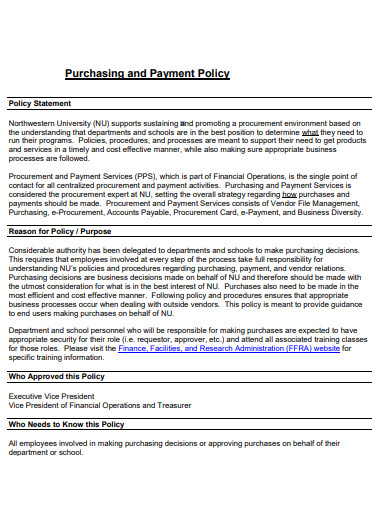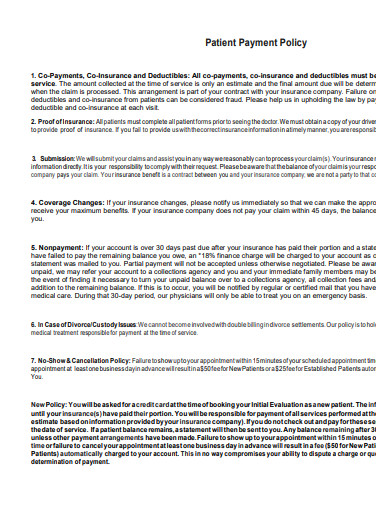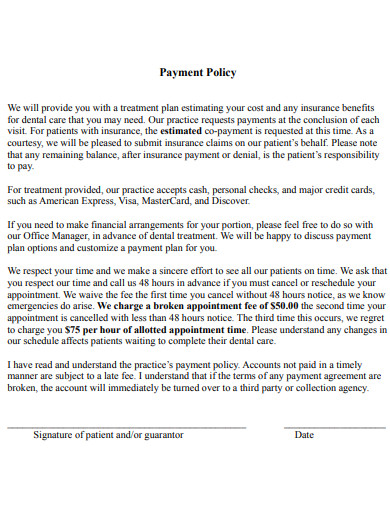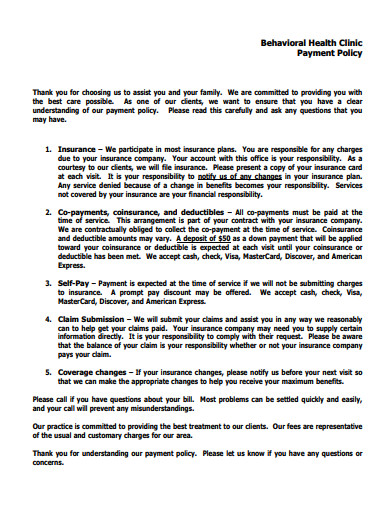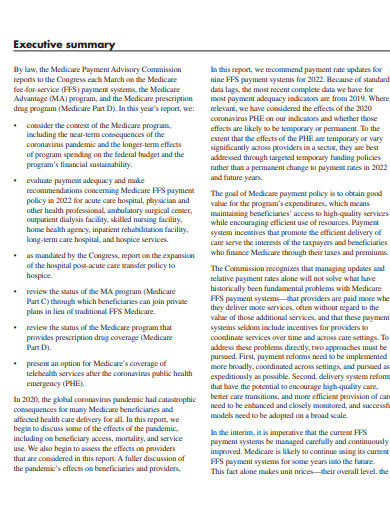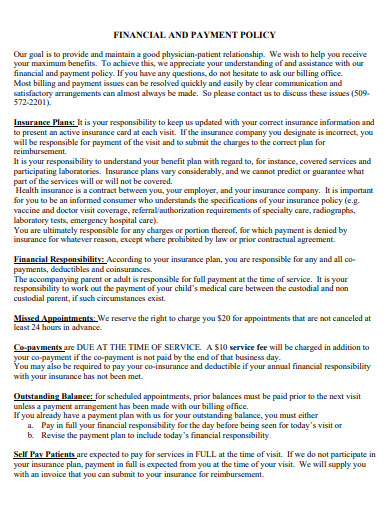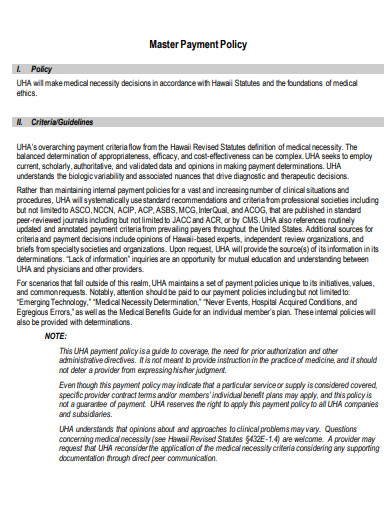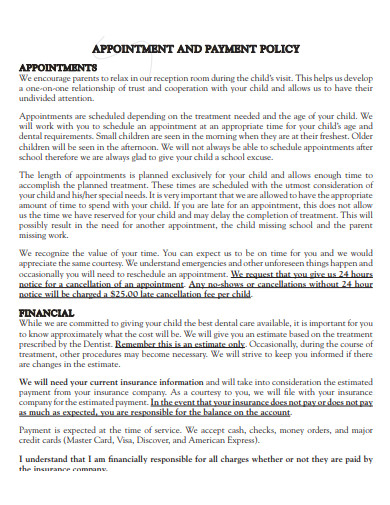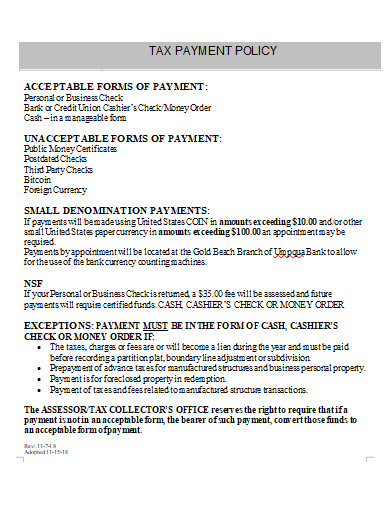If a client avails of your service as an event coordinator or a freelance graphic designer, chances are the agreement you have made does not require a full payment upfront until the project or tasks is completed. Since this is a common practice in so many types of businesses, you need to come up with a payment policy to guide clients on the payment process. The need to prepare this policy is to make sure you or your company is paid on time. And that clients before they would commit, are well-informed of what is expected of them to do once they need to pay the amount due.
Payment policies such as these are usually applicable to installment transactions or as mentioned for projects where the contractor gets paid after every milestone. To know more about this let us discuss this further below. And if you need to start working on this policy, check out our free payment policy samples that are downloadable on this page.
10+ Payment Policy Samples
1. Freelancer Payment Policy Template
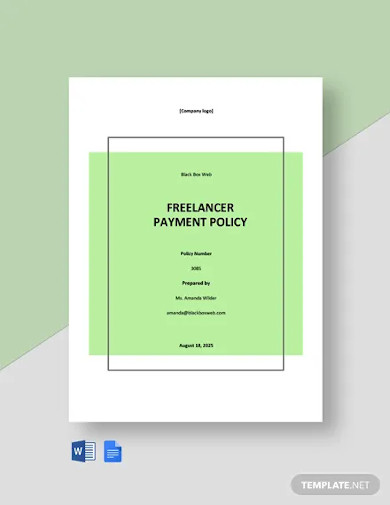
2. Advertising Agency Payment Policy
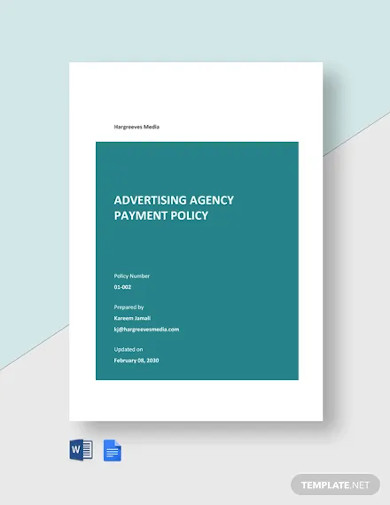
3. Purchasing and Payment Policy
4. Patient Payment Policy
5. Sample Payment Policy
6. Health Clinic Payment Policy
7. Medicare Payment Policy
8. Financial and Payment Policy
9. Master Payment Policy
10. Appointment Payment Policy
11. Tax Payment Policy
What Is a Payment Policy?
One of the first few things clients would ask before they could purchase a product or avail of a service is the payment terms. Some would prefer paying in installments, so this is where you need to properly explain your payment policy. Since clients would need to know if they are able to meet the payment requirements and in your case as an entrepreneur, this policy will help get paid on time and help simplify the entire payment process.
The payment policy is usually written down as part of a contract or agreement, which must be carefully read by the client. You can also set up these policies not only for your direct clients but is also applicable between business associates such as suppliers and vendors.
How To Create a Payment Policy?
It is important to set up a payment policy not only just to get paid on time, but to make sure you are paid back by the client. Different industries have their payment policies which they expect their clients to follow and give your business some legal protection should a patient fail to pay what you are entitled to collect. Also in a way, this would help the client plan their budget and be able to pay on time. There must be a systematic way when it comes to collecting payment, so to help, you create a payment policy here are several guidelines below.
1. Consider the Item/Service and its Value
If your client has already made a deposit, so what is left is to pay is the remaining balance. In some cases, a company would need to consider what type of item they are selling and how much it costs. There could be long-term layaway plans when it comes to expensive items such as vehicles or properties. The value of the items or service may affect how you set up the terms in your policies. Perhaps items that are much cheaper can have shorter installment terms, or whichever is applicable to your business.
2. Payment Due
Payments are usually made on a monthly basis, so pick what date of the month that is feasible (usually this is every 15th or the 30th). Make sure to also include details of the charges and interest rates for late payments.
3. Form of Payment
List down the forms of payment your company is willing to accept (credit cards, cash, checks) and the address or bank details for the deposit.
4. Billing Process
Indicate how you would bill the client, for example by providing an invoice 5 or 10 days prior to the due date. And indicate that it will be sent via email or a physical copy.
5. Policy Regarding Non-Payment
Outline a procedure or process in case the client fails to pay the amount due for more than 3 months or so.
FAQs
How can late Payment affect Cash Flow?
Late payments can negatively affect cash flow since the company would need to pay their expenses such as wages, utilities and etc. If there is more cash outflow, this can create a deficit.
What Is an Invoice?
An invoice is a form of billing document that a company uses to bill its client. This would contain details of the transaction such as the item or service, the amount due, and the payment due date.
What Is 50/50 Payment?
This is where a client pays an initial 50% deposit before work can begin on a specific project and the other half is paid when it is finished.
To make sure your client pays you on time, you need to create a payment policy for every business transaction. This can also protect your company in the process. To make it easier for you to prepare this policy, don’t forget to download our free templates!
Related Posts
FREE 16+ Payment Notice Samples & Templates in PDF
FREE 3+ Event Contract Proposal Samples in PDF MS Word ...
FREE 10+ Private Lease Agreement Samples in MS Word Google ...
FREE 10+ Advance Payment Invoice Templates in PDF MS Word ...
FREE 6+ Payment Calculator Mortgage Samples in PDF Excel
FREE 10+ Restaurant Event Contract Samples in MS Word Google ...
FREE 10+ Daycare Contract Samples in PDF
FREE 10+ Accounts Payable Samples & Templates in PDF MS Word
FREE 10+ Insurance Incident Report Samples in PDF DOC
FREE 7+ Employee Manual Samples in MS Word PDF
FREE 9+ Sample Privacy Policy Samples in PDF
FREE 10+ Compensation & Benefit Form Samples in MS Word ...
FREE 10+ Customer Billing Statement Samples in PDF
FREE 10+ Equipment Rental Contract Samples [ Heavy, Payment ...
FREE 10+ Employee Attendance Policy Samples in PDF MS Word

